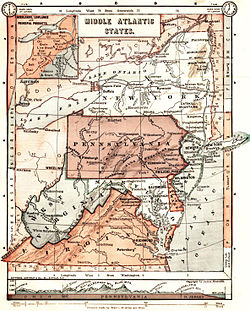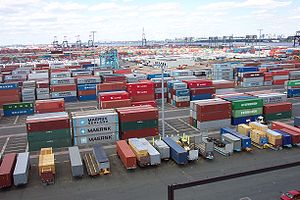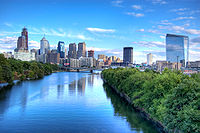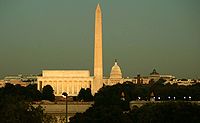- Mid-Atlantic states
-
Mid-Atlantic Region 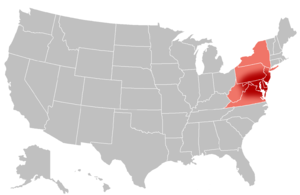
Regional statistics Composition  Delaware
Delaware
 Maryland
Maryland
 New Jersey
New Jersey
 New York
New York
 Pennsylvania
Pennsylvania
 District of Columbia
District of Columbia
 Virginia
Virginia
 West Virginia
West VirginiaArea
- Total
191,308.5 sq mi (495,486.74 km²)Population
- Total
- Density
57,303,316 (2008 est.)[1]
299.53/sq mi (116/km²)Largest city  New York City (pop. 8,246,310[2])
New York City (pop. 8,246,310[2])GDP $2.962 trillion (2007)[3] Metropolitan Areas New York–Newark
Baltimore–Washington
Philadelphia–Wilmington
Pittsburgh
Richmond-Petersburg
Norfolk–Virginia BeachThe Mid-Atlantic states, also called middle Atlantic states or simply the mid Atlantic, form a region of the United States generally located between New England and the South. Its exact definition differs upon source, but the region often includes Delaware, Maryland, New Jersey, Pennsylvania, Washington D.C., Virginia, New York, West Virginia.
The Mid-Atlantic has played an important role in the development of American culture, commerce, trade, and industry, yet it is one of the least self-conscious of American regions.[4] It has been called "the typically American" region by Frederick Jackson Turner. Religious pluralism and ethnic diversity have been important elements of Mid-Atlantic society from its settlement by Dutch, Swedes, English Catholics, and Quakers through to the period of English rule, and beyond. After the American Revolution, the Mid-Atlantic region hosted each of the historic capitals of the United States, including the current federal capital, Washington D.C.
In the early part of the nineteenth century, New York and Pennsylvania overtook Virginia as the most populous states and the New England states as the country's most important trading and industrial centers. Large numbers of German, Irish, Italian, Jewish, Polish, and other immigrants transformed the region, especially coastal cities such as New York City, Newark, Philadelphia, and Baltimore, but also interior cities such as Pittsburgh, Albany, and Buffalo.
New York City, with its skyscrapers, subways, and headquarters of the United Nations, emerged in the twentieth century as an icon of modernity and American economic and cultural power. It suffered the brunt of the September 11 attacks, along with two other places in the Mid-Atlantic, Arlington, Virginia and Shanksville, Pennsylvania. By the 21st century, the coastal areas of the Mid-Atlantic were thoroughly urbanized. The Northeast Corridor and Interstate 95 linked an almost contiguous sprawl of suburbs and large and small cities, forming the Mid-Atlantic portion of the Northeast megalopolis, one of the world's most important concentrations of finance, media, communications, education, medicine, and technology. Waves of Puerto Ricans, Chinese, Indian, Italian, Mexican, Russian, Dominican, Jamaican, Filipinos, Pakistani, Guatemalan, Salvadoran, and other immigrants now are further transforming the Mid-Atlantic economy and culture.
The Mid-Atlantic is a relatively affluent region of the nation, having 43 of the 100 highest-income counties in the nation based on median household income and 33 of the top 100 based on per capita income. Most of the Mid-Atlantic states rank among the 15 highest-income states in the nation by median household income and per capita income.
Contents
Defining the Mid-Atlantic
There are differing interpretations as to the composition of the Mid-Atlantic. Sometimes, the nucleus is considered to consist of Maryland, Delaware, and Virginia, with additional states possibly included.[5] Other sources consider New Jersey, New York, and Pennsylvania to be the core Mid-Atlantic states, with others sometimes included.[6] For example, since the 1910 census, the Mid-Atlantic Census Division has included New Jersey, New York, and Pennsylvania, which combined with the New England Division, comprised the Northeast Census Region.[7]
West Virginia and parts of Virginia are atypical of this region in several ways. They are the only states to lie primarily within the Southern American dialect region,[8] and the major religious tradition in both states is Evangelical Christian, 31% in Virginia and 36% in West Virginia.[9] Although a few of West Virginia's eastern panhandle counties are considered part of the Washington, D.C. MSA, the major portion of the state is rural, and there are no major or even large cities.[10]
The 'typically American' region
An 1897 map displays an inclusive definition of the Mid-Atlantic region, including Delaware, New Jersey, New York, Pennsylvania.
Frederick Jackson Turner wrote in 1893 about the important role the Mid-Atlantic or "Middle region" had played in the formation of the national American culture, and defined it as "the typical American region".[11]
“ The Middle region, entered by New York harbor, was an open door to all Europe. The tide-water part of the South represented typical Englishmen, modified by a warm climate and servile labor, and living in baronial fashion on great plantations; New England stood for a special English movement-- Puritanism. The Middle region was less English than the other sections. It had a wide mixture of nationalities, a varied society, the mixed town and county system of local government, a varied economic life, many religious sects. In short, it was a region mediating between New England and the South, and the East and the West. It represented that composite nationality which the contemporary United States exhibits, that juxtaposition of non-English groups, occupying a valley or a little settlement, and presenting reflections of the map of Europe in their variety. It was democratic and nonsectional, if not national; "easy, tolerant, and contented;" rooted strongly in material prosperity. It was typical of the modern United States. It was least sectional, not only because it lay between North and South, but also because with no barriers to shut out its frontiers from its settled region, and with a system of connecting waterways, the Middle region mediated between East and West as well as between North and South. Thus it became the typically American region. Even the New Englander, who was shut out from the frontier by the Middle region, tarrying in New York or Pennsylvania on his westward march, lost the acuteness of his sectionalism on the way. ” —The Frontier in American History
History
Shipping and trade have been important to the Mid-Atlantic economy since the beginning of the colonial era.
The explorer Giovanni da Verrazzano was the first European since the unenduring Norse colonization of the Americas to have explored the Atlantic coast, travelling from what is now called The Carolinas to Newfoundland. He entered what is now called Lower New York Bay in 1524, greeted by what are presumed to have been the Lenape in canoes, the Native American people who long inhabited that area. Henry Hudson later extensively explored that region in 1609 and claimed it for the Dutch, who then created a fur-trading post in Albany in 1614. Jamestown, Virginia was the first permanent English colony in North America seven years earlier in 1607..
From early colonial times, the Mid-Atlantic region was settled by a wider range of European people than in New England or the South. The Dutch New Netherland settlement along the Hudson River in New York and New Jersey, and for a time, New Sweden along the Delaware River in Delaware, divided the two great bulwarks of English settlement from each other. The original English settlements in the region notably provided refuge to religious minorities, Maryland to Roman Catholics, and Pennsylvania to Quakers and the mostly Anabaptist Pennsylvania Dutch. In time, all these settlements fell under English colonial control, but the region continued to be a magnet for people of diverse nationalities.
The area that came to be known as the Middle Colonies served as a strategic bridge between the North and South. The New York and New Jersey campaign during the American Revolutionary War saw more battles than any other theater of the conflict. Philadelphia, midway between the northern and southern colonies, was home to the Continental Congress, the convention of delegates who organized the American Revolution. The same city was the birthplace of the Declaration of Independence in 1776 and the United States Constitution in 1787, while the United States Bill of Rights was drafted and ratified, and the first Supreme Court of the United States sat for the first time, in the first capital under the Constitution at New York City.
While early settlers were mostly farmers, traders, and fishermen, the Mid-Atlantic states provided the young United States with heavy industry and served as the "melting pot" of new immigrants from Europe. Cities grew along major ports, shipping routes, and waterways. Such flourishing cities included New York City and Newark on opposite sides of the Hudson River, Philadelphia on the Delaware River, and Baltimore on the Chesapeake Bay.
Cities and urban areas
Metropolitan Areas
Metropolitan Areas with more than 1,000,000 people:
- New York-Newark-Bridgeport, NY-NJ-CT-PA CSA
- Washington-Baltimore-Northern Virginia, DC-MD-VA-WV CSA
- Philadelphia-Camden-Wilmington, PA-NJ-DE-MD CSA
- Pittsburgh-New Castle, PA MSA
- Virginia Beach-Norfolk-Newport News, VA-NC MSA
- Richmond-Petersburg, VA MSA
- Buffalo-Niagara-Cattaraugus, NY CSA
- Albany-Schenectady-Amsterdam, NY CSA
- Rochester-Batavia-Seneca Falls, NY CSA
Large cities
Cities with more than 200,000 people:
- Arlington
- Baltimore
- Buffalo
- Chesapeake
- Jersey City
- New York City
- Newark
- Norfolk
- Pittsburgh
- Philadelphia
- Richmond
- Rochester
- Virginia Beach
- Washington, D.C.
State capitals
- Albany, New York
- Annapolis, Maryland
- Charleston, West Virginia
- Dover, Delaware
- Harrisburg, Pennsylvania
- Richmond, Virginia
- Trenton, New Jersey
See also
References
- ^ "State & County QuickFacts". US Census Bureau. http://factfinder.census.gov/servlet/GCTTable?_bm=y&-geo_id=01000US&-_box_head_nbr=GCT-T1-R&-ds_name=PEP_2008_EST&-format=US-40S. Retrieved 2009-04-09.
- ^ "2005–2007 American Community Survey 3-Year Estimates". US Census Bureau. http://factfinder.census.gov/servlet/STTable?_bm=y&-qr_name=ACS_2007_3YR_G00_S0101&-geo_id=31200US356203651000&-context=st&-ds_name=ACS_2007_3YR_G00_&-tree_id=3307&-_lang=en&-format=&-CONTEXT=st. Retrieved 2009-04-09.
- ^ "News Release: GDP by State". Bureau of Economic Analysis. http://www.bea.gov/newsreleases/regional/gdp_state/2008/pdf/gsp0608.pdf. Retrieved 2009-04-16.
- ^ "United States. (2009). In Encyclopædia Britannica.". http://search.eb.com/eb/article-77992. Retrieved 2009-04-09.
- ^ "Word Net Definition". http://wordnetweb.princeton.edu/perl/webwn?s=mid-atlantic. Retrieved 2009-04-09.
- ^ ""The American Heritage Dictionary of the English Language: Fourth Edition. 2000. "Middle Atlantic States" entry"". http://www.bartleby.com/61/5/M0280500.html. Retrieved 2009-04-09.
- ^ "Census Regions and Divisions of the United States". http://www.census.gov/geo/www/us_regdiv.pdf. Retrieved 2007-11-03.
- ^ Labov, William, Sharon Ash and Charles Boberg, Atlas of North American English: Phonetics, Phonology and Sound Change, Mouton de Gruyter, 2005 Southern Regional Map
- ^ PEW Forum on Religion & Public Life
- ^ U.S. Census 2000 Report
- ^ Frederick Jackson Turner, The Frontier in American History.
Bibliography
- Robert Marzec. The Mid-Atlantic Region: The Greenwood Encyclopedia of American Regional Cultures (2004)
United States (Outline) History Pre-Columbian era · Colonial era (Thirteen Colonies · Colonial American military history) · American Revolution (War) · Federalist Era · War of 1812 · Territorial acquisitions · Territorial evolution · Mexican–American War · Civil War · Reconstruction era · Indian Wars · Gilded Age · African-American Civil Rights Movement (1896–1954) · Spanish–American War · Imperialism · World War I · Roaring Twenties · Great Depression · World War II (Home front) · Cold War · Korean War · Space Race · African-American Civil Rights Movement (1955–1968) · Feminist Movement · Vietnam War · Post-Cold War (1991–present) · War on Terror (War in Afghanistan · Iraq War) · Timeline of modern American conservatismTopicsDemographic · Discoveries · Economic (Debt Ceiling) · Inventions (before 1890 · 1890–1945 · 1946–1991 · after 1991) · Military · Postal · Technological and industrialFederal
governmentLegislature - Congress
Senate
· Vice President
· President pro tem
House of Representatives
· Speaker
Judiciary - Supreme Court
Federal courts
Courts of appeal
District courtsExecutive - President
Executive Office
Cabinet / Executive departments
Civil service
Independent agencies
Law enforcement
Public policy
Intelligence
Central Intelligence Agency
Defense Intelligence Agency
National Security Agency
Federal Bureau of InvestigationPolitics Divisions · Elections (Electoral College) · Foreign policy · Foreign relations · Ideologies · Local governments · Parties (Democratic Party · Republican Party · Third parties) · Political status of Puerto Rico · Red states and blue states · Scandals · State governments · Uncle SamGeography Cities, towns, and villages · Counties · Extreme points · Islands · Mountains (Peaks · Appalachian · Rocky) · National Park System · Regions (Great Plains · Mid-Atlantic · Midwestern · New England · Northwestern · Southern · Southwestern · Pacific · Western) · Rivers (Colorado · Columbia · Mississippi · Missouri · Ohio · Rio Grande) · States · Territory · Water supply and sanitationEconomy Agriculture · Banking · Communications · Companies · Dollar · Energy · Federal Budget · Federal Reserve System · Financial position · Insurance · Mining · Public debt · Taxation · Tourism · Trade · Transportation · Wall StreetSociety TopicsCrime · Demographics · Education · Family structure · Health care · Health insurance · Incarceration · Languages (American English · Spanish · French) · Media · People · Public holidays · Religion · SportsArchitecture · Art · Cinema · Cuisine · Dance · Fashion · Flag · Folklore · Literature · Music · Philosophy · Radio · Television · TheaterIssuesCategories:- Regions of the United States
- Northeastern United States
- Southern United States
- Census regions of the United States
Wikimedia Foundation. 2010.

